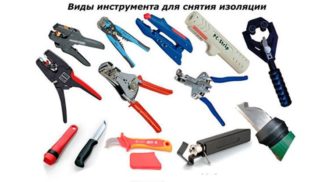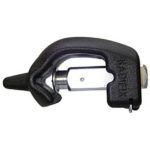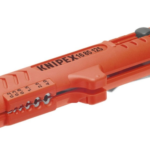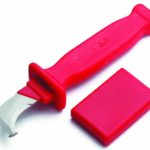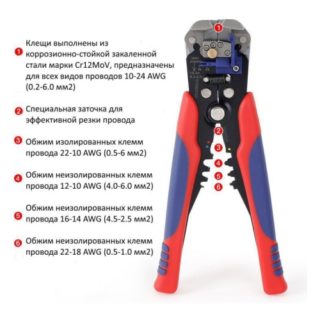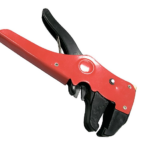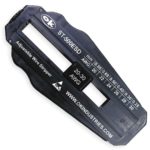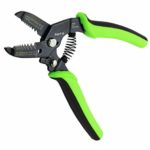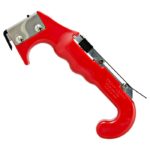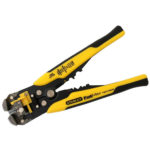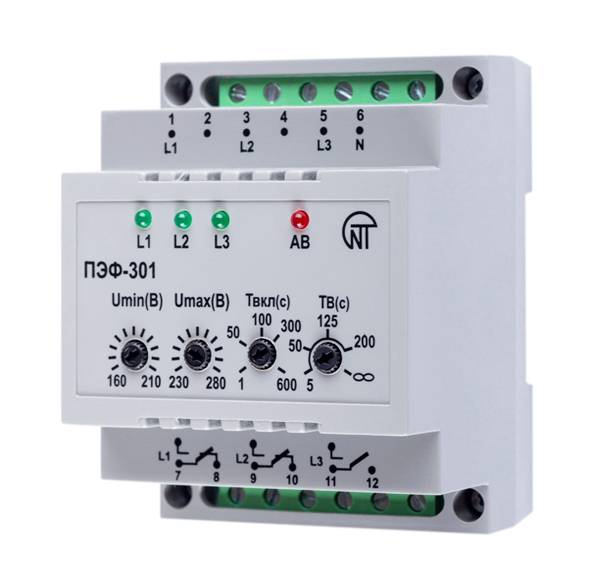It is often necessary to remove the covering from the electrical cable. This requires devices that can handle the task without damaging the inner conductor. Wire strippers and other manual or automatic tools are used. The choice of option depends on the diameter of the conductor, the thickness of the sheath, and the amount of work.
Hand tools
- mechanical stripper;
- ticks;
- knife;
- pliers for round conductors;
- pliers;
- a knife to remove the shells.
Mechanical stripper
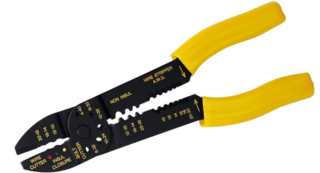
This is a crimper stripper for stripping wire ends. Consists of nippers and pliers, with which the ends are crimped and crimped. To remove the braid, the wire is clamped into the hole of the required diameter, in a circular motion, the insulating cover is removed. It's a simple, cheap tool. It has a short service life and is used for simple operations. The crimp jaws have 6-7 holes, which allows working with elements of different diameters.
Stripping pliers

Pliers (pliers) - a universal tool for stripping insulation and other operations performed during electrical work. In the front part there are 6 standard sizes of split holes, the range of cross-sections is from 0.5 to 3 mm. In the second half, there is a long zigzag connector, with the help of which the ends are crimped, the wire is bent, and thin soft wires are cut. This is a handy, inexpensive wire stripper.
Stripping pliers
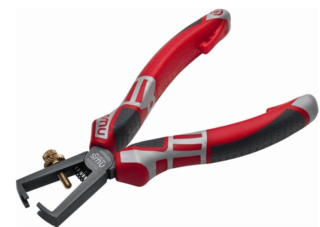
The device is equipped with handles, which are covered with a dielectric shell, an adjusting screw that allows you to change the diameter of the hole. To remove the sheathing, the cable is lightly bitten, the tool is turned and the cut cover is pulled. The wires installed in the hole of the pliers must not be strongly squeezed or deformed. This will scratch the steel strands of the conductor.
It is inconvenient to work with ticks for a long time, but they are suitable for homework. They are used for various cable cross-sections. The device is used in places of difficult access. The handles of the pliers are dielectric coated to protect against electric shock.
Stripping pliers for round cables
This is a round detachable handle. It is opened, the conductor is inserted, clamped and rotated. The cutting edge makes an incision in a circle, the sheath is removed when pulled. The device is designed for cables of large cross-section and round shape.
Sheathing knife
This knife has a retractable blade and a metal clip that presses the cable against the cutter. The rotary mechanism allows you to cut the shell along its length and circumference. The blade extends to the thickness of the braid, which eliminates damage to the conductor itself.
Stripping knife
This is a wire stripper. The blade is bent into a hook. The braid is removed by moving away from oneself, the knife is placed at an acute angle, excluding damage to the steel conductors of the conductor. The heel at the end of the hook limits the cut. It controls the depth of cut by removing the top shell.Not suitable for thick coatings.
Semi-automatic tools
Stripping pliers
They are a clamp with a built-in blade. Separate it and put the cable in the grooves, close it, press the button, the insulation is removed. Wire stripping pliers provide a neat removal of the outer cover, pre-treat the coaxial cables to fit into the F-connector. The mechanism removes the shell in an arbitrary area, cleans single-core, multi-core, flat elements.
Automatic wire stripping pliers
An automatic pliers or stripper simplifies the work of stripping the wire. The stripper is equipped with one socket, its size is automatically adjusted to the diameter of the laid cable. The range of diameters used is from 0.2 to 6 mm. This is a multifunctional tool, its use allows you to remove insulation, crimp ferrules, cut a wire, twist individual cores into one bundle.
Wire stripper
Semi-automatic pliers for stripping wire insulation, unlike manual models, are equipped with a mechanism that performs actions by pressing a button. There is a type of pliers that removes the sheath from a twisted pair.
Tool recommendations
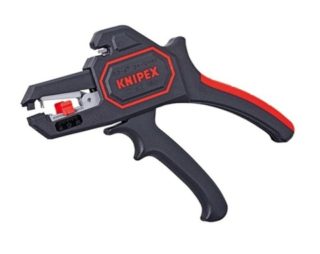
When choosing mechanisms for stripping a cable, pay attention to the following characteristics:
- Maximum and minimum diameter.
- Availability of replaceable knives.
- Cutting diameter and depth adjustment.
- Additional operations.
- Manufacturer.
If the instrument is used for personal needs occasionally, they stop at simple devices, taking into account the parameters of the cable used. When performing electrical work during self-repair, devices of a wide spectrum of action are chosen that cut off the wire, squeeze the ends of the conductor, and remove the insulation.
Whenever possible, devices are used where it is not necessary to select holes according to the diameter of the conductor, the mechanism adjusts the parameters automatically. For long-term operation, they purchase high quality tools from reliable manufacturers.
Manufacturers
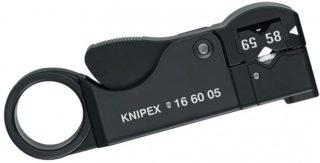
Products of the German company Knipex are considered reliable in Russia. Automatic stripper Knipex KN 1262180 is used for solid and stranded wires with an area of 0.2-6.0 mm2. The tool adjusts to the diameter automatically, gently strips the insulation. The long head will provide access to the secluded area.
Knipex KN-166005SB is used to strip coaxial cables. The tool removes the outer casing, shielding and insulation in one pass. Equipped with three built-in knives, each adjustable in depth using a hex wrench. The insulation is sheared when the stripper is rotated 360 degrees.
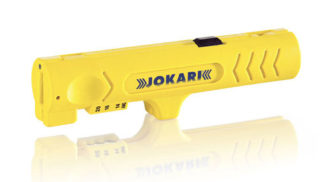
The German company Jokari produces the Jokari JK 30140 stripper designed for PVC coated cables. This automatic device is used where the conductor branches.
Automatic stripper Stanley FMHTO-96230 does not require lengthy adjustment. They set the length of the section, the diameter is adjusted by itself. Used for round and flat stranded cables, cleans all conductors at the same time. Suitable for cables with a diameter of 0.2-2.6 mm. Its weight is 350 g.
At home, with rare use, they use the Greenlee PA1117 universal wire cleaner. The stripper is equipped with 6 holes with diameters from 0.64 to 2.6 mm, an additional device for cutting the flat cable. Weight 185 g. Not used for armored and steel cables.
The Jonard JIC-4366 stripper is equipped with two blades, one for stripping the outer sheath of the cable, the other for the PVC insulation. Replaceable blades. The device is convenient to work with rigid insulation.
There are times when it is necessary to strip the insulation from a thin conductor (0.25-0.8 mm) or remove the hardened coating from old cables. For this, thermal strippers OK ST-500ESD are used. Under the influence of heating, the braid melts and is easily removed. Such a tool is rarely used in everyday life, it does not belong to the universal, it requires the removal of harmful substances by melting the insulation.
How the stripper differs from the crimper

To obtain full high-quality contact of individual elements of the electrical circuit, a crimping tool is used for crimping bare and insulated conductors. A crimper is a press pliers that crimp the ferrule and sleeve into a single electrical circuit. The procedure is as follows:
- The cable is placed in the cutting part and the sheath is removed.
- The cleaned section of the conductor is inserted into the sleeve and placed between the matrices of the desired size.
- Squeezing the handles, crimp the connection.
If necessary, the operation is repeated several times, moving the pliers along the tip. The actions of a crimper are different from those of a stripper. The main purpose of the crimper is to form a reliable connection between the cable and the electricity consumer.
The crimper comes with a set of dies. They provide the difference in the size of the cross-section of the ferrules and their functionality. The most used plates for crimping terminals are of the NSHVI and NSHV brands. The dies have a numerical designation of the cross-section of the sleeve and tip.
For crimping multicore cables and cross-sections of 16 mm2, massive PK-16U pliers are used. Single wires are not crimped with this model - the powerful force on the jaws of the matrix contributes to its breaking.
Computer wire connections use RJ-45 polymer connectors to connect a twisted pair of wires. For crimping, crimpers with special matrices are used; it is performed in several stages.
They are especially relevant when crimping sheath terminals, where soldering of parts cannot be used - irons, microwave ovens, electric kettles, and other heating devices. Instead of a crimper, you can use a universal stripper, with which the insulation is removed and the ends of the round conductor are crimped.

